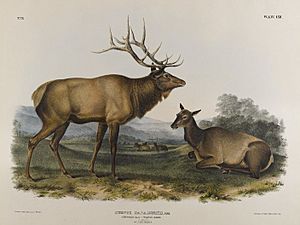Eastern elk facts for kids
Quick facts for kids Eastern elk |
|
|---|---|
 |
|
| A drawing of the extinct Eastern elk by John James Audubon in 1847. | |
| Conservation status | |
| Scientific classification |
|
| Kingdom: | Animalia |
| Phylum: | Chordata |
| Class: | Mammalia |
| Order: | Artiodactyla |
| Family: | Cervidae |
| Subfamily: | Cervinae |
| Genus: | Cervus |
| Species: | |
| Subspecies: |
†C. c. canadensis
|
| Trinomial name | |
| Cervus canadensis canadensis (Erxleben, 1777)
|
|
The eastern elk (Cervus canadensis canadensis) was a type of extinct elk that lived in the northern and eastern United States and southern Canada. Sadly, the very last Eastern elk was shot in Pennsylvania on September 1, 1877. By 1880, the United States Fish and Wildlife Service officially declared this subspecies extinct. Another type of elk, the Merriam's elk, also disappeared around the same time.
However, in 2017, a group called the IUCN decided to reclassify most North American elk. They now consider many of them to be the same as C. c. canadensis, except for the Tule elk and Roosevelt elk. If this is true, it means the Eastern elk might not be completely gone. This is because the Rocky Mountain elk, which was brought to the eastern U.S. in the 20th century, is now considered part of the same group.
Contents
What Did They Look Like?
A fully grown male Eastern elk, called a bull, was very large. It could weigh up to 1,000 pounds (about 450 kg). It stood about 50 to 60 inches (127-152 cm) tall at its shoulder. Its antlers, which are like horns, could grow to be six feet (1.8 meters) long!
A Brief History of the Eastern Elk
By the late 1400s, elk were found all over North America. Eastern elk lived in the huge forests of the Eastern Woodlands region, stretching as far west as the Mississippi River.
Over the next few centuries, as more people settled in these areas, the number of elk began to drop. This happened because of too much hunting and the loss of their thick woodland homes. A famous nature artist, John James Audubon, wrote in 1851 that only a few elk could still be found in the Allegheny Mountains. They were almost completely gone from other places they used to live. By the end of the 1800s, the Eastern elk had completely disappeared.
Most of what we know about these elk comes from old bones and historical records. DNA studies in 2004 showed that North American elk are a different species from European red deer.
Here's when Eastern elk disappeared from different areas:
- South Carolina: 1737
- Georgia: 1770
- North Carolina: 1780
- Maryland and Vermont: 1800
- New Jersey: 1805
- Arkansas and Quebec: 1830
- Indiana and Ohio: 1840
- Louisiana: 1842
- New York: 1847
- Illinois and Kentucky: 1850
- Virginia: 1855
- Tennessee: 1865
- Pennsylvania: 1868
- Wisconsin: 1875
- Michigan: 1880
- Iowa: 1885
- Minnesota: 1896
- Missouri: 1898
Bringing Elk Back to Their Old Homes
Not long after the last Eastern elk was killed in Pennsylvania, officials worried about too many elk in Yellowstone National Park. They offered to give some of these elk to anyone who wanted them. The Pennsylvania Game Commission accepted this offer. They started a program to bring elk back to Pennsylvania.
Between 1913 and 1926, the Commission released 177 elk in 10 counties. Fifty of these animals came from Yellowstone. Today, Pennsylvania's elk herd has more than 800 animals. They live across an area of about 800 square miles (2,072 square km).
In 1990, studies were done to see if wild elk could live in their old eastern habitats again. Once these studies showed it was possible, healthy Rocky Mountain elk were brought in. These elk came from places like Arizona, Kansas, New Mexico, North Dakota, Oregon, Utah, and Alberta’s Elk Island National Park. They were released into areas where Eastern elk used to live.
Today, successful elk populations have been brought back to many places:
- Arkansas (1991)
- Wisconsin (1995)
- Ontario (2001)
- Kentucky, Tennessee, and Great Smoky Mountains National Park (2002)
- Michigan (1919)
- The Missouri Ozarks (2011)
- Virginia (2012)
- Southern West Virginia (late 2016)
Studies have also been done in Illinois and New York, but elk have not yet been brought back to those states.
Possible Surviving Elk Genes
Could there be more left of the Eastern elk than just old bones? In 1905, 18 elk were sent to Fiordland National Park in New Zealand. This was a gift from Theodore Roosevelt, who was the U.S. President. These elk were survivors from a group of 20. Half came from Yellowstone National Park, and half came from a game reserve in Massachusetts. The elk from Massachusetts are thought to be Eastern elk that Native Americans caught in northern Minnesota.
Some people believe that the Eastern elk's genes might still be in the New Zealand elk. This could explain some unusual features seen in the New Zealand elk, like certain shapes of their antlers. However, it's unlikely that a pure bloodline still exists. Over time, these elk mixed with red deer that moved into the area. Also, the government later considered all introduced animals, including elk, to be pests. This led to efforts to control their numbers. Today, the wild herd in Fiordland is much smaller and is made up of mixed-breed elk.
Eastern elk might also have survived in the large forests of Ontario, Canada. While there isn't strong proof, many people reported seeing a group of elk near Sault Ste. Marie, Ontario and Sault Ste. Marie, Michigan in the early 1980s. These elk could possibly be of Eastern elk origin, and some might still be living in the wild parts of Ontario today.


